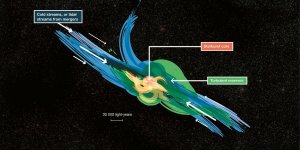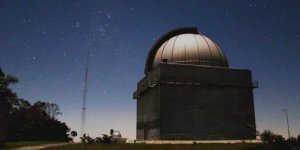| News / Space News |
Hubble Uncovers the Farthest Star Ever Seen
More than halfway across the universe, an enormous blue star nicknamed Icarus is the farthest individual star ever seen. Normally, it would be much too faint to view, even with the world’s largest telescopes. But through a quirk of nature that tremendously amplifies the star’s feeble glow, astronomers using NASA’s Hubble Space Telescope were able to pinpoint this faraway star and set a new distance record. They also used Icarus to test one theory of dark matter, and to probe the make-up of a foreground galaxy cluster.

MACS J1149+2223, shown at left, sits between Earth and the galaxy that contains the distant star. The panels at the right show the view in 2011, without Icarus visible, compared with the star's brightening in 2016. Image credits: NASA, ESA, and P. Kelly/University of Minnesota.
The star, harbored in a very distant spiral galaxy, is so far away that its light has taken 9 billion years to reach Earth. It appears to us as it did when the universe was about 30 percent of its current age.
The cosmic quirk that makes this star visible is a phenomenon called “gravitational lensing.” Gravity from a foreground, massive cluster of galaxies acts as a natural lens in space, bending and amplifying light. Sometimes light from a single background object appears as multiple images. The light can be highly magnified, making extremely faint and distant objects bright enough to see.
In the case of Icarus, a natural “magnifying glass” is created by a galaxy cluster called MACS J1149+2223. Located about 5 billion light-years from Earth, this massive cluster of galaxies sits between the Earth and the galaxy that contains the distant star. By combining the strength of this gravitational lens with Hubble’s exquisite resolution and sensitivity, astronomers can see and study Icarus.
The team had been using Hubble to monitor a supernova in the far-distant spiral galaxy when, in 2016, they spotted a new point of light not far from the magnified supernova. From the position of the new source, they inferred that it should be much more highly magnified than the supernova.
When they analyzed the colors of the light coming from this object, they discovered it was a blue supergiant star. This type of star is much larger, more massive, hotter, and possibly hundreds of thousands of times intrinsically brighter than our Sun. But at this distance, it would still be too far away to see without the amplification of gravitational lensing, even for Hubble.
Detecting the amplification of a single, pinpoint background star provided a unique opportunity to test the nature of dark matter in the cluster. Dark matter is an invisible material that makes up most of the universe’s mass.
By probing what’s floating around in the foreground cluster, scientists were able to test one theory that dark matter might be made up mostly of a huge number of primordial black holes formed in the birth of the universe with masses tens of times larger than the Sun.
The results of this unique test disfavor that hypothesis, because light fluctuations from the background star, monitored with Hubble for 13 years, would have looked different if there were a swarm of intervening black holes. (NASA)
YOU MAY ALSO LIKE



